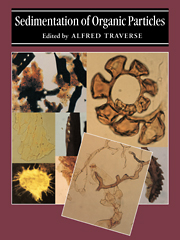Book contents
- Frontmatter
- Contents
- Editor's preface
- List of contributors
- I Introduction
- II Studies of palynosedimentation in modern environments
- 2 The sorting of spores and pollen by water: experimental and field evidence
- 3 Transport and deposition of pollen in an estuary: signature of the landscape
- 4 Pollen preservation in alkaline soils of the American Southwest
- 5 Wind and water transport and sedimentation of miospores along two rivers subject to major floods and entering the Mediterranean Sea at Calvi (Corsica, France)
- 6 Sedimentation of land-derived palynomorphs in the Trinity–Galveston Bay area, Texas
- 7 The genesis and sedimentation of phytoclasts with examples from coastal environments
- 8 Palynofacies of some recent marine sediments: the role of transportation
- 9 Maceral palynofacies of the Louisiana deltaic plain in terms of organic constituents and hydrocarbon potential
- 10 Organic sedimentation in a carbonate region
- 11 An approach to a standard terminology for palynodebris
- 12 Relationships of palynofacies to coal-depositional environments in the upper Paleocene of the Gulf Coast Basin, Texas, and the Powder River Basin, Montana and Wyoming
- III Reconstruction of late Cenozoic vegetation and sedimentary environments from palynological data
- IV Application of data on palynosedimentation to solution of geological problems
- V Appendix
- Index
8 - Palynofacies of some recent marine sediments: the role of transportation
Published online by Cambridge University Press: 06 January 2010
- Frontmatter
- Contents
- Editor's preface
- List of contributors
- I Introduction
- II Studies of palynosedimentation in modern environments
- 2 The sorting of spores and pollen by water: experimental and field evidence
- 3 Transport and deposition of pollen in an estuary: signature of the landscape
- 4 Pollen preservation in alkaline soils of the American Southwest
- 5 Wind and water transport and sedimentation of miospores along two rivers subject to major floods and entering the Mediterranean Sea at Calvi (Corsica, France)
- 6 Sedimentation of land-derived palynomorphs in the Trinity–Galveston Bay area, Texas
- 7 The genesis and sedimentation of phytoclasts with examples from coastal environments
- 8 Palynofacies of some recent marine sediments: the role of transportation
- 9 Maceral palynofacies of the Louisiana deltaic plain in terms of organic constituents and hydrocarbon potential
- 10 Organic sedimentation in a carbonate region
- 11 An approach to a standard terminology for palynodebris
- 12 Relationships of palynofacies to coal-depositional environments in the upper Paleocene of the Gulf Coast Basin, Texas, and the Powder River Basin, Montana and Wyoming
- III Reconstruction of late Cenozoic vegetation and sedimentary environments from palynological data
- IV Application of data on palynosedimentation to solution of geological problems
- V Appendix
- Index
Summary
Introduction
Palynological study of the organic matter content of sediments reveals information about the nature and state of preservation of constituent elements of both the sediments in general and the organic matter in particular. These observations have led to the establishment of a number of criteria to assist in reconstruction of the paleogeographical and sedimentological conditions prevailing at the time of deposition, as well as the geological history of the sediment.
Several authors have proposed relationships which may have existed between paleogeography, in the broadest sense, and the microscopic character of the sedimentary organic matter. The ultimate aim of these investigations has been to understand the origin and alteration of this organic material, and, more generally, of the sediment in which it is preserved (Haseldonckx, 1974; Hart, 1986; Pocock et al., 1987). Most often these studies have concentrated on Pre-Quaternary sedimentary formations. The paleogeography prevailing at the time of deposition can be deciphered only from reconstructions where hypotheses sometimes become important, reducing the validity of the proposed conclusions.
It was to alleviate such difficulties, and particularly to understand and consequently interpret the geological data more accurately, that the ORGON project, a series of French scientific cruise-expeditions with organic geochemical goals, was undertaken during the years 1976–1983, to study the organic content of Late. Pleistocene to Holocene deposits from various ocean environments (see Fig. 8.1). Only extant phenomena which can be described or quantified are taken into consideration. This project, essentially based on observed facts, enables us to delimit, in some well-defined cases, the role and importance of the various factors affecting the nature and state of preservation of organic matter in marine sediments.
- Type
- Chapter
- Information
- Sedimentation of Organic Particles , pp. 129 - 140Publisher: Cambridge University PressPrint publication year: 1994
- 1
- Cited by



